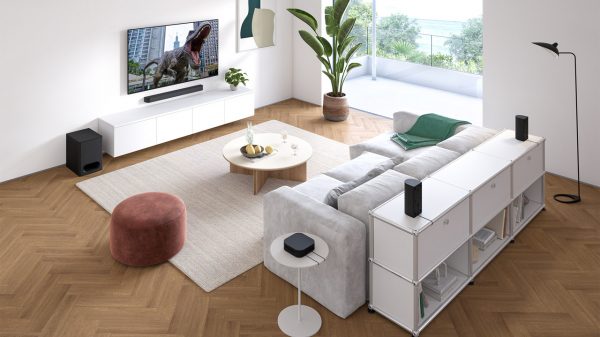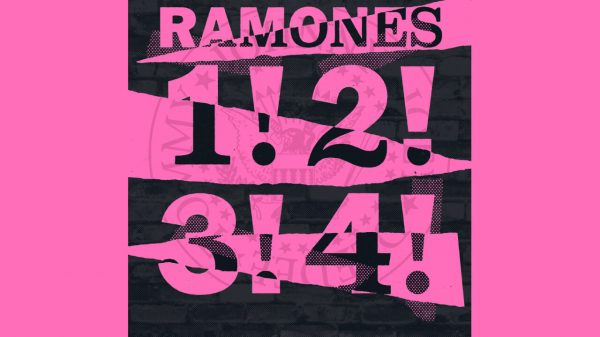Brett Crockett, Director of Sound Research at Dolby Labs explains what home theater enthusiasts need to know about Dolby Atmos — the new surround sound format for home theater and cinemas. Dolby Atmos sound systems add overhead speakers which heightens the realism of your cinematic experience. For the home, Dolby Atmos combines traditional home theater speaker layouts with either ceiling-mounted speakers or new Dolby Atmos-enabled speakers to create a plane of sound above the listener.
Dolby Atmos has the amazing ability to have sounds come from above you. In the movie Noah, for instance, Dolby Atmos in the cinema made it sound like the torrential rains were pouring down from the sky on top of you. And if you saw Godzilla in a Dolby Atmos movie theatre, hearing the monster roar above you was beyond realistic—it was terrifying.
If you’re willing and able to install speakers in your ceiling, there will be great options. If that’s not possible for you—and for many people, it isn’t—our partners will offer new Dolby Atmos-enabled speakers that produce full, detailed overhead sound from speakers located where your conventional speakers are now.
If you already have speakers that you love, you can choose an add-on, Dolby Atmos-enabled speaker module that complements your existing speakers. (In fact, many people will place the modules right on top of their current speakers.)
How does Dolby Atmos create the sensation of sounds above your head if there are no speakers above your head?
It’s complicated, but it all comes down to understanding the physics of sound waves and understanding the way your brain interprets those sound waves.
Our partners will also offer home theater receivers and other entertainment devices to decode and deliver the Dolby Atmos experience in your home. And you likely won’t need a new Blu-ray player—existing players that fully conform to the Blu-ray specification will be able to support Dolby Atmos content on a Blu-ray Disc.
But Dolby Atmos isn’t just about hardware. At its core, it’s a powerful creative tool that lets filmmakers use exceptionally lifelike sound to deliver the full impact of their artistic vision. We’re working with studios and production houses to help them create Dolby Atmos soundtracks for a broad range of movies and TV for home viewing. You’ll start to see Dolby Atmos titles on Blu-ray and streaming video services this fall, with more to come at the start of 2015.
How is Dolby Atmos different than typical channel-based home theater systems?
Dolby Atmos is the first home theater system that is based not on channels, but on audio objects. What is an audio object? Any sound heard in a movie scene—a child yelling, a helicopter taking off, a car horn blaring—is an audio object. Filmmakers using Dolby Atmos can decide exactly where those sounds should originate and precisely where they move as the scene develops.
Thinking about sound in this way eliminates many of the limitations of channel-based audio. In a channel-based system, filmmakers have to think about the speaker setup: Should this sound come from the left rear surrounds or the left side surrounds? With Dolby Atmos, filmmakers just have to think about the story: Where is that yelling child going to run? The Dolby Atmos system, whether in the cinema or a home theater, has the intelligence to determine what speakers to use to precisely recreate the child’s movement in the way the filmmakers intend.
Dolby Atmos is also far more flexible and adaptable than channel-based home theater. In a channel-based system with channel-based content, the number of speakers is fixed—a 7.1 system always consists of seven speakers and one subwoofer. With Dolby Atmos, in contrast, you have amazing flexibility: you can get the full experience with just seven speakers or get an even richer, more detailed sound by adding more speakers. As you add speakers, a Dolby Atmos enabled receiver will automatically determine how to use them to create fantastic, immersive audio.
If Dolby Atmos allows me to add more speakers, why do I see A/V receivers with just 11 channels?
Many hardware partners are building or planning to build Dolby Atmos enabled A/V receivers and speakers. Those partners decide what product configurations make the most sense for their customers. But the Dolby Atmos system itself is almost unlimited. If you have the space and budget, you can build a Dolby Atmos system with as many as 24 speakers on the floor and 10 overhead speakers. One of our hardware partners is planning to release an A/V receiver with 32 channels.
Do I have to install speakers in my ceiling?
In real life, sounds come from all around us, including overhead. Having the ability to recreate overhead sounds is a key element in making Dolby Atmos sound so realistic.
The obvious way to create overhead sounds is to install speakers in or on your ceiling. But that’s not the only way to get great overhead sound.
Through our knowledge of psychoacoustics and sound physics, we’ve developed speakers that can create overhead sound even though they’re only a few feet off the floor. These speakers fire sound upward, where it reflects off the ceiling to produce an incredibly lifelike recreation of overhead sound—you really have to hear them to believe them.
You will be able to buy integrated Dolby Atmos enabled speakers that include both traditional forward-firing speakers and upward-firing speakers in one speaker cabinet. (Those speakers have two sets of posts, one for the traditional speaker and one for the upward-firing speaker.)
But if you already have conventional speakers you like, you can simply buy Dolby Atmos enabled speaker modules. These include only the upward-firing speakers. You can put the modules on top of your current speakers or on another nearby surface.

Will Dolby Atmos enabled speakers work in my room?
Dolby Atmos enabled speakers can produce an incredibly accurate Dolby Atmos experience in many kinds of rooms. You’ll get the best sound if your ceiling is flat (not vaulted or angled) and made of an acoustically reflective material, such as standard drywall, plaster, concrete, or wood. While we designed the technology for rooms with ceiling heights of 8 to 9 feet (2.4 m to 2.7 m), our testing indicates that you can still hear incredible Dolby Atmos sound in rooms with ceilings as high as 14 feet (4.3 m), though the effect may become more diffuse in rooms with higher ceilings.
Recessed lighting fixtures, chandeliers, crown molding, and heating or air conditioning vents in your ceiling do not noticeably interfere with the Dolby Atmos experience.
How many overhead speakers do I need?
For the best Dolby Atmos experience, we recommend four overhead speakers for most homes. But you can get great sound with just two.
If this is not a channel-based system, why are there predefined speaker positions?
Because Dolby Atmos is new to home theater, we defined a few “reference” speaker configurations to ensure that early customers could have a great experience while having the option to keep most of the equipment they already have.
Among those reference setups are the 5.1.2 configuration, which involves adding two ceiling or Dolby Atmos enabled speakers to a traditional 5.1 system, and the 7.1.4 configuration, which starts with a traditional 7.1 system and adds four ceiling or Dolby Atmos enabled speakers.
But we believe this is just the beginning. Because the Dolby Atmos object-based audio system is so adaptable, you can use many other speaker configurations. No matter what system you build, the Dolby Atmos format and system will adapt itself to output the best audio experience possible.
How will I get Dolby Atmos movies?
We wanted to ensure that entertainment fans could get Dolby Atmos movies in the same ways they get movies now, on Blu-ray Disc or through streaming video services.
We invented new scalable algorithms and extensions to Dolby TrueHD, our Blu-ray format, and Dolby Digital Plus, which is used by leading streaming video providers. Both formats now support Dolby Atmos sound, meaning that you’ll be able to play Dolby Atmos movies from your Blu-ray player or through your favorite streaming service.
Will I have to replace my Blu-ray player or my HDMI cables?
Any Blu-ray player that fully conforms to the Blu-ray specification can play a Dolby Atmos movie without a firmware update. Just remember to set your player to audio bitsteam output mode.
There’s also no need to buy new HDMI cables. The current HDMI spec fully supports Dolby Atmos audio.
What if I build a Dolby Atmos system but want to play content that isn’t in Dolby Atmos?
A Dolby Atmos home theater can play any stereo, 5.1, or 7.1 content. You can choose to have our technology automatically adapt that channel-based signal to use the full capabilities of your new system, including your overhead speakers, ensuring that you hear realistic and immersive sound.
More about Dolby Atmos:
- What is Dolby Atmos For Home Theater? (Audioholics)
- Experience Dolby Atmos with Headphones (Dolby.com)
- How to Shop for Dolby Atmos Products (Crutchfield)
Related reading:











































